[ Outlands ] [ Spirelands | Ringlands | Gate-Towns | Hinterlands | Splinterlands | Underlands ]
The Outlands Year
Today’s Date on the Outlands is:
If you look at anything natural, you’re bound to find rings there somewhere. Trees have ’em, day and night follow each other like a dog chasing its tail, and years are circles in time that never end. Any planar knows that the Unity of Rings is a concept the planes themselves embody.
You’d be surprised then, that most planar bloods don’t bother with calendars. Many planar creatures are immortal, and simply don’t care about time as much as primes. Besides, they’ve got nothing to measure the passing years by: On most planes the weather’s part of the landscape, and doesn’t change in seasons. The Outlands are different. Any berk could tell you the planes in the Great Road impose their landscapes on the Concordant Plane near its gate-towns, but only planewalkers who’ve spent some time Out-of-Town know that the weather of the Outlands is also dictated by other planes.
The chant goes that the planes in the Great Road lap at the Outlands like waves on a shore. As they wash against the Plane of Concentric Rings, dimensional winds blow in through the gate-town, bringing with them a taste of the other plane’s climate. Of course, the weather’s most noticeable nearest to the gate town, but the effect’s enough that Outlanders have based a calendar of seventeen months upon the planar seasons.
Each month has 21 days (that’s three weeks of seven days each, for the Mathematicians amongst you), plus an extra week of Astral Days, giving 364 days to a complete cycle; at least on the Outlands. They say there used to be another day, until Sung Chiang stole it. Well, that’s as maybe, but most folk don’t really give a toss. After all, half the planars are immortal, so what’s one pesky day to them? The Outlander calendar’s well known in Sigil, though the ‘official’ dating system of the Fraternity of Order is also used there.
The months of the Outlands Cycle are described below, along with the dominant attitude the climate adopts, tips for planewalkers, and general helpful chant. ‘Course, if you’re in the realm of a power, the climate depends entirely upon the high-up’s say-so. In that case, you’re on your own, basher.

The Philosophical Spring
Spar — Acheron
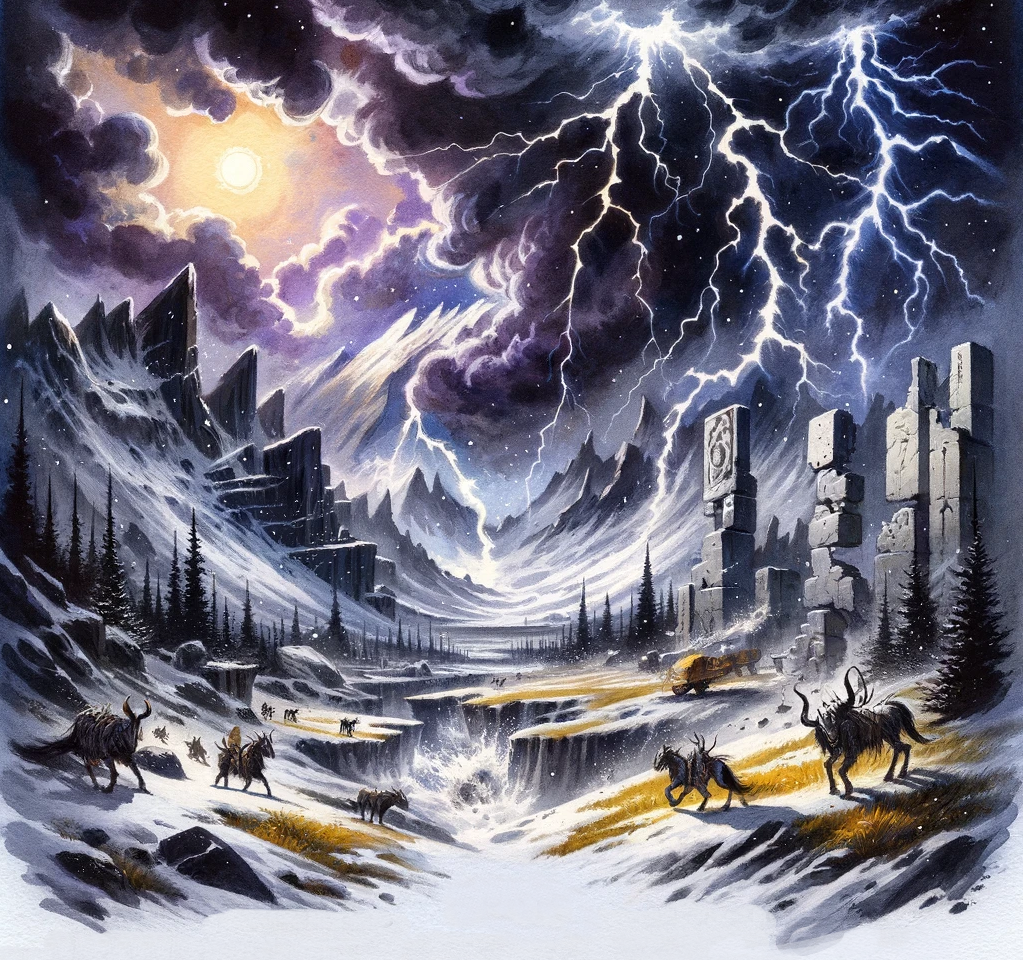
Officially the start of the cycle — as much as a ring can have a beginning — Spar’s the first month of the philosophical spring. You wouldn’t guess it, though, because like all things from the battle plane it welcomes itself in with a bang. Storms vent the fury of the lost causes of Acheron, and the air is split by lightning most nights. Outland evenings grow long, dark and cloudy, though the days bring brief respite from the strife. Spar’s a popular time for generals to launch surprise attacks, as the sound of thunder and extra dark evenings makes ambushes easy. This month also brings earthquakes — could be that Acheron’s cubes bump into the edges of the Outlands now and then (wherever they are!)
Revolvis — Mechanus
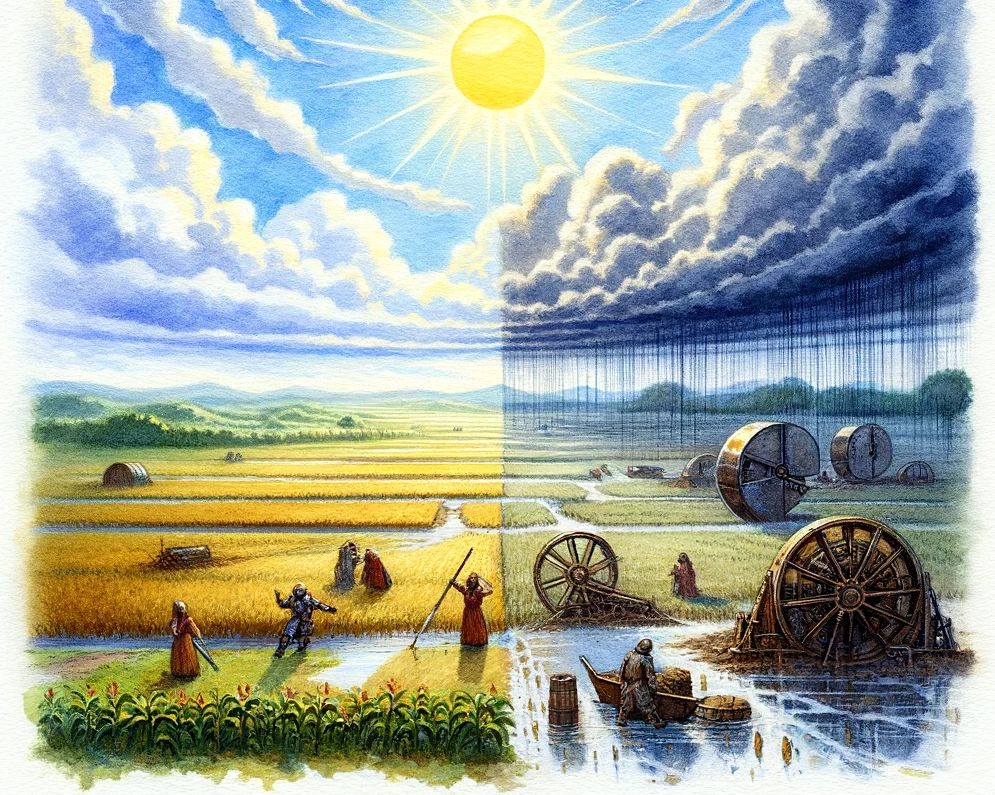
Identical to the plane it blows in from, the weather in Revolvis comes in a methodical pattern. One day it’s warm and bright, the next cloudy and overcast, the third raining. Then the cycle repeats itself. While terminally boring, it’s a good time for farmers to plant their crops for the coming year, as they always know exactly what the skies promise each day. A faint smell of grinding metal and oil is carried by breezes for the whole month, and strangely, rain in Revolvis doesn’t cause metal to rust. Lucky for modrons, that.
Halcyon — Arcadia

Halcyon promises calm, subdued weather — gentle rain, placid skies, and zephyrs rather than gales — and it usually delivers, too. It’s a good growing season for plants, and is also a popular month for travellers to begin their journeys. Superstition marks Halcyon as a lucky month for lovers and merchants, too. The sun-lit days and starry nights of Arcadia radiate into the Outlands during Halcyon; it’s the only time when there are heavenly bodies in the skies of the Plane of Balance. Fortune tellers read a great deal into the conjunctions and constellations which appear during Halcyon; they’re supposed to hint at secret events in the coming year.
Nimbus — Mount Celestia

As spring matures into summer, the skies are painted with the glorious metallic sheens seen on the Seven Holy Slopes. Their radiance lingers late into the evening, creating dazzlingly beautiful sunsets, and rendering even the darkest alley a little safer. When it rains, the water is pure and clean, with the sharp scent of righteousness, and carries with it the blessings of the powers of Mount Celestia. This makes it uncomfortable for fiends, undead and their ilk, but not actually damaging. Nimbus is a season of ceremonies and celebrations, ritual fasting and devotions to the powers.

The Philosophical Summer
The Reaping — Bytopia

By now the early crops are ripe, and it’s time for harvesting. In the spirit of hard work, the Bytopian climate usually provides the Outlands with gentle weather; not as glorious as Zenith, but easier to work in. Indep burgs across the Land hold festivals celebrating the fruits of their labours, and even Sigilians (who’re generally immune to the weather-cycle of the Outlands, living in their dank, misty Cage) notice the abundance of wholesome fruits and vegetables in their markets. The good weather lasts just long enough for farmers to bring in their crops and plough their fields for the autumn harvests, then the rains begin, revitalising the soil with life-giving nutrients.
Zenith — Elysium

Zenith is looked-forward to by most cutters; it’s by far the friendliest month of the cycle. The height of the planar summer; hot, but just moist enough for the flowers to bloom. The air’s filled with buzzing bees, garish butterflies and tropical birds drinking nectar. Evenings are long and balmy, and there’s never a storm or shower of rain to spoil a picnic. It’s considered bad form to be at war during Zenith; it’s traditionally a time when feuding burgs set aside their differences for the brief summer month, and sometimes even the fiends leave the plane alone for a while. ‘Course, they make up for lost time as soon as Zenith’s over.
The Flocking — Beastlands

Most folks don’t even notice the weather in the Flocking; they’re too busy avoiding the wildlife. Seems it ain’t just winds that blow in from the Beastlands, it’s the natives as well: the Flocking is migration season, for practically every animal. Flights of swallows and skeins of geese pour forth from the Beastlands, while stampedes of wildebeest, prides of leomarh and troops of kangaroos swarm across the plains of the Outlands. Chant is they’re seeking fresh pastures, but they always return to the Beastlands where the grass is greener. It’s a great time for game; it’s a rare night when high-ups from Sigil don’t make the trip down to the Outlands for an aeserpent hunt. The Flocking’s also a time when the Nature spirits of the Outlands awaken; the ancient stone circles of Tir Na Og and leylines running around the plane fairly buzz with mystical energy.
Exhilarus — Arborea

Whatever happens, it comes thick and fast. Summer’s coming to an end, and the weather itself seems to enjoy celebrating the fun it has had. The evenings boast spectacular sunsets and aurorae borealis, and the days offer blazing heatwaves and dry lightning storms. Sheltering in the cool forests ain’t always a good idea though, as the faerie folk come a-frolicking in force about this time. If you’re predicting the weather, take your best guess and double it, ’cause Exhilarus is nothing if not excessive. The skies are a brilliant azure, and the evenings warm and long. Hells, sometimes night forgets to arrive altogether, the day’s enjoying itself so much! The best summer parties are held now: don’t miss the week-long Fête Baroque in Sylvania at the end of the month — it usually takes them ’till Nimbus to clear up!

The Philosophical Autumn
Bravura — Ysgard
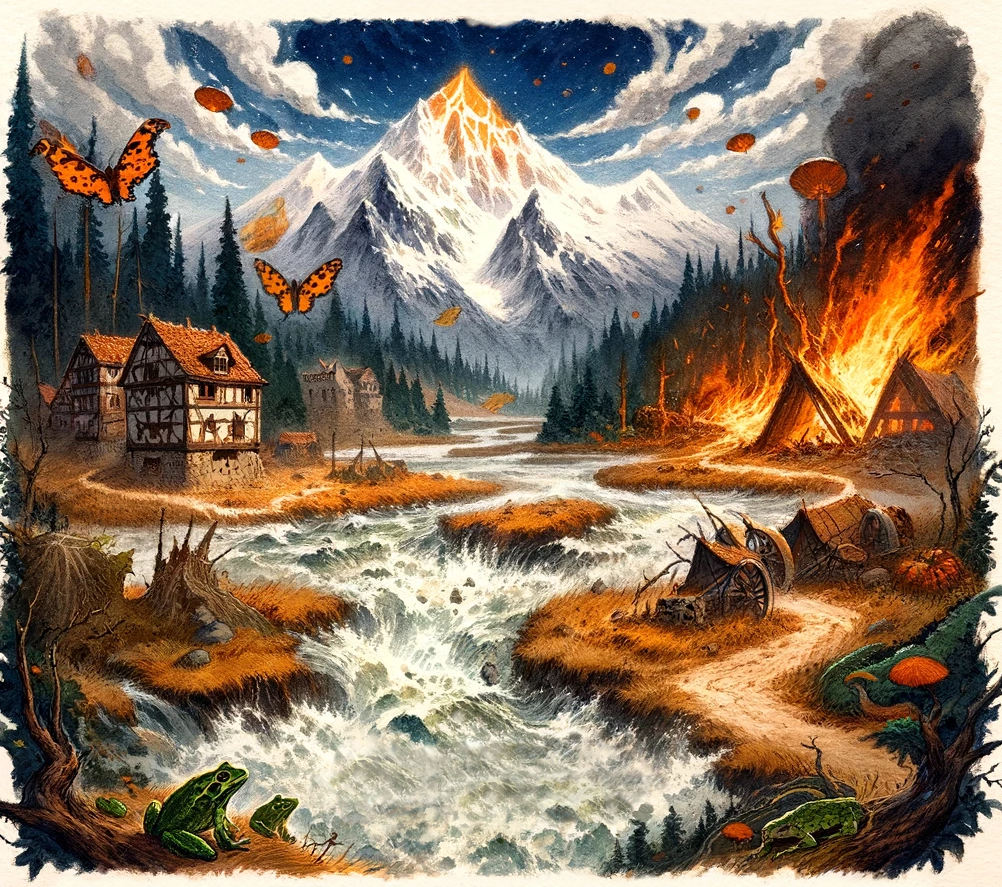
Weather for the courageous, it’s been called. After all, Bravura’s the start of the unpredictable planar autumn, and it wants you to remember that, cutter. You’d certainly have to be bold (read: leatherheaded) if you tried anything adventuresome in this month. During Bravura natural hazards are augmented; mountain avalanches become common, river plains flood, forest fires blaze across the land, sea gales descend even upon lakes and droughts parch the deserts. Add to that locust swarms, plagues of frogs, infestations of biting mosquitoes, flash blizzards, earthquakes and volcanic eruptions, and you’re starting to get the picture! It ain’t malicious like some months, mind — the weather seems more of a test of mettle. The chant goes that if a blood’s stubborn enough, he’ll weather the storms and the powers’ll respect him all the more for it. Basically, if you’re planning on travelling, take extra precautions, and don’t expect an easy ride.
Fracas — Limbo

It’s useless trying to explain the weather in Fracas. Sometimes there isn’t any for the whole month, and other times Mayhem actually happens instead, then Fracas kicks in after. It rains fish, granite blocks, or fire. The skies can turn green, the wind blow in two directions at once, and the rivers boil as they flow upstream — all in one morning. Folk’ve found though, that the really strange things happen in the wilderness; Fracas doesn’t seem so disruptive around burgs, except Xaos of course (but you can rely on aXos to be the exception). There’s a group of strange bloods who journey in from Limbo during Fracas, who reckon they can control the weather with their wills; Anarchs, they call themselves. Maybe that’s true, but darker whispers reckon they’re trying to make the Outlands chaotic enough to slip into Limbo itself.
Mayhem — Pandemonium
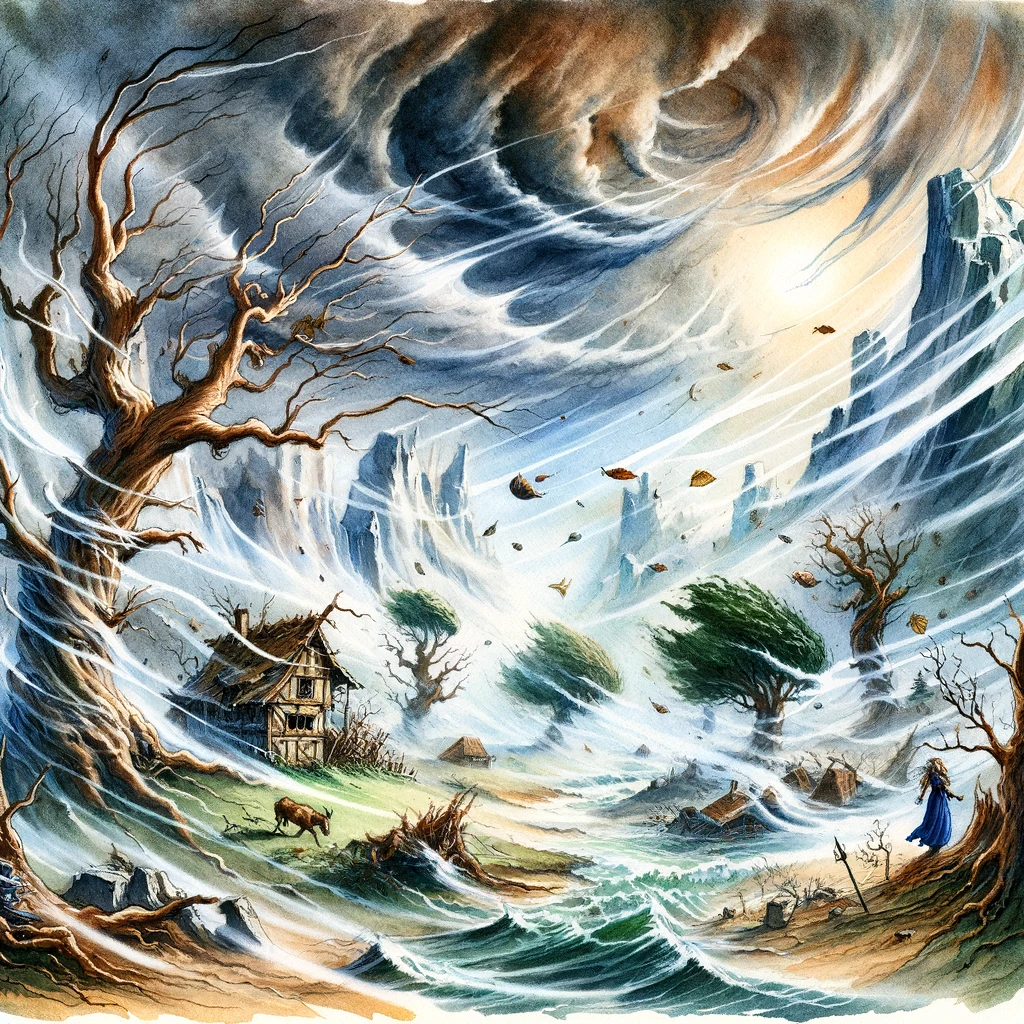
A sod always knows when Mayhem’s hit; as often as not the first gale rips his shutters off their hinges. The wind’s non-stop, varying from a gusty breeze to a screaming hurricane. Trees are uprooted, rivers change their course, houses tumble down and tempers flare. It’s a good month to go barmy, what with the endless moan of the wind and the constant chilly breezes under doors and windows. Worse still, Mayhem’s a time of pessimism and anxiety, for Outlanders know the easy times have come to an end. The worst it yet to come…
The Rotting — The Abyss
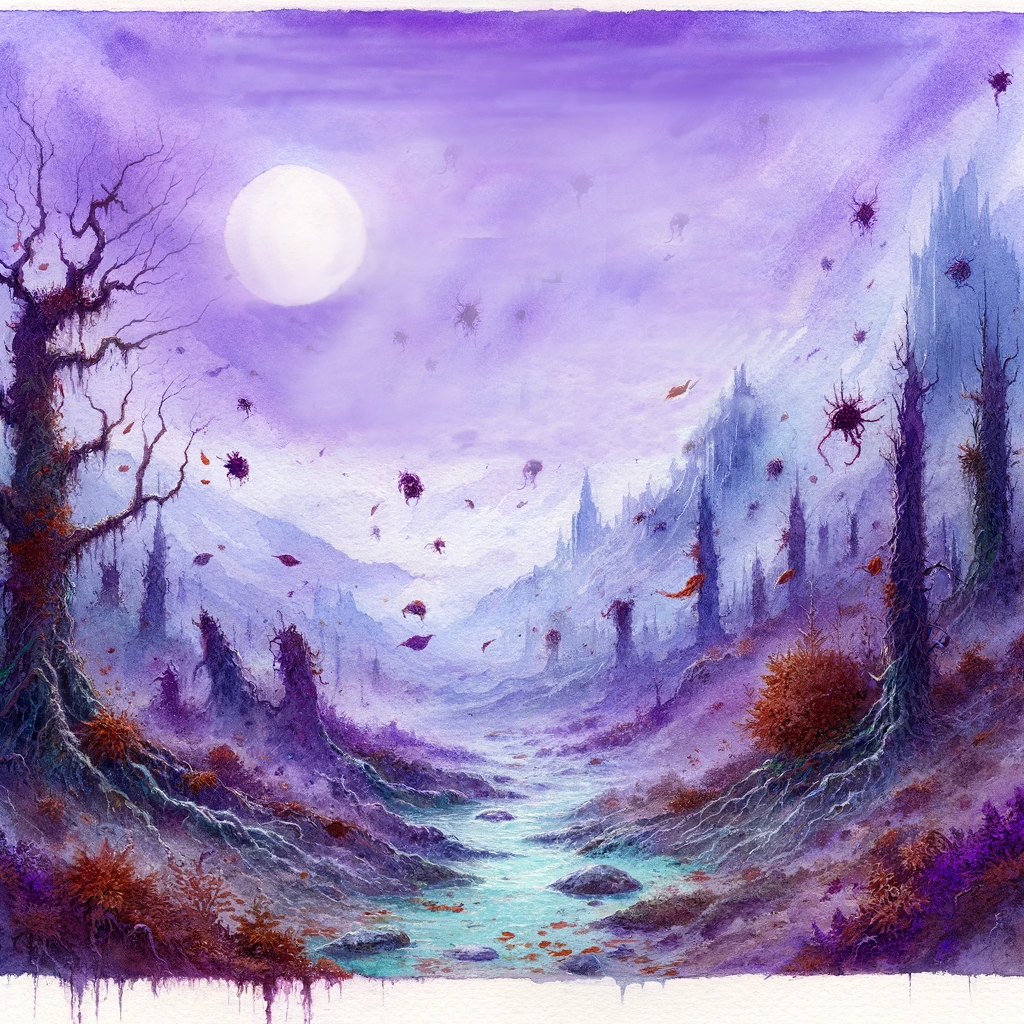
It starts off harmless enough; the heavy clouds clear to reveal amethyst purple skies for the first time in months. The chill winds of the Abyss blow in, heralding the death of the autumn and promising the onslaught of the planar winter. The plants drop their leaves — that’s all the plants mind, not just the trees. A plant-infecting leprosy sweeps across the Land; whole forests’ve been reduced to clumps of amputated sticks. Then the rotting begins. The stench of mildew and decay pervades the Outlands, and it’s often now that plagues start. If friends of yours fall victim to a Rotting disease, you’d best be careful of their corpses. The chant is that the spirits of those who die during the Rotting are restless, and they’ll come back as ghosts unless they’re properly buried. Thing is, nobody agrees on what’s ‘proper’.

The Philosophical Winter
Ironskies — Carceri
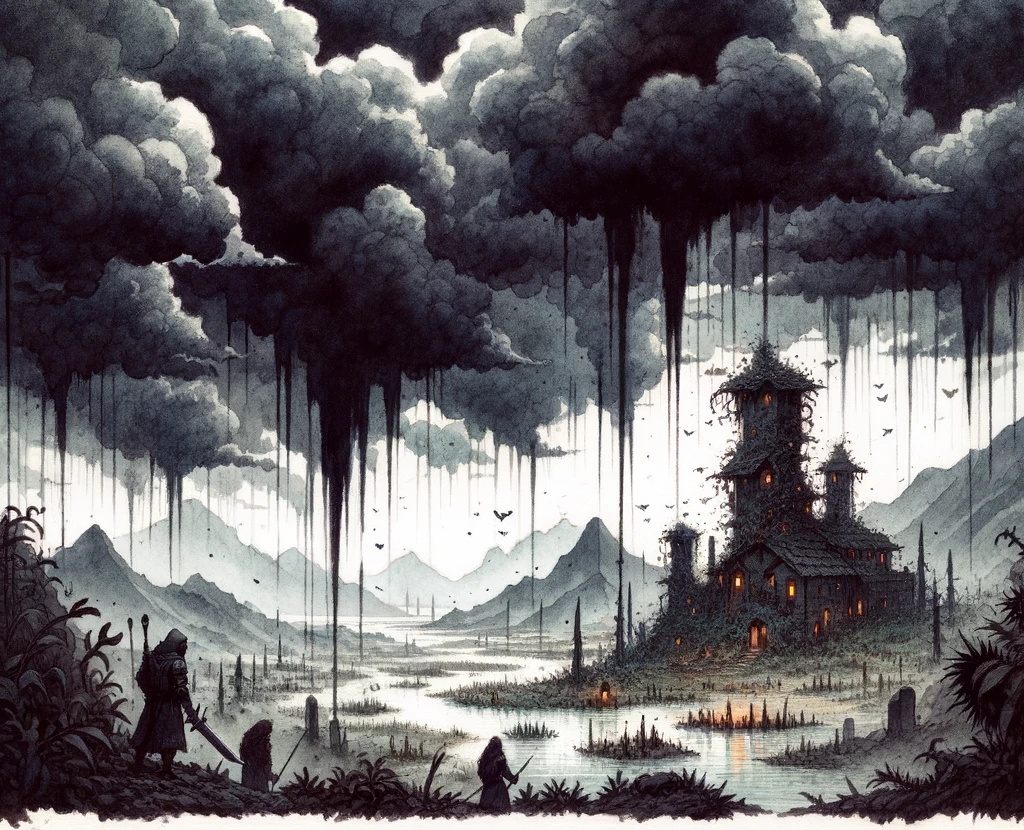
Dense black clouds block out most light for the whole month. There’s often hunger about this time; little gets the chance to grow during Ironskies (or Forlorn for that matter), and it’s about now that burgs start quarrelling and trade caravans come under threat from starving bandits. Only razorvine seems to thrive in the oppressive climate, entombing whole houses overnight. Many a sod’s been trapped indoors for the duration of Ironskies by spiteful vines: you’d better make sure you’ve got plenty of food in store! The little rain that falls is as bitter as a Carcerian petitioner, and even bloods are gripped by an overwhelming fear that the dense clouds will just drop to the ground and squash them flat. Cutter, it’s been known to happen! It’s a funny sight, but most berks wander round for the whole month with a stooped head, just in case the sky should fall.
Forlorn — Gray Waste

Grim: that sums up Forlorn in a word. Nothing much happens weather-wise; the grey skies and dusty air shut out anything. There’s never rain, nor a breeze to blow away the scent of misery. Plants and animals visibly wilt, as their spirits’re slowly consumed by the Gray Waste. Everything takes on a monochromatic tone, and folk become subdued and depressed. It’s a strange thing for primes; they’re used to the depths of winter being physically cold, not emotionally cold. More fool them. You’d expect suicide rates to rise what with all the gloominess, but it seems sods haven’t even got the spirit for that. The Bleakers love Forlorn, of course.
Infernus — Gehenna
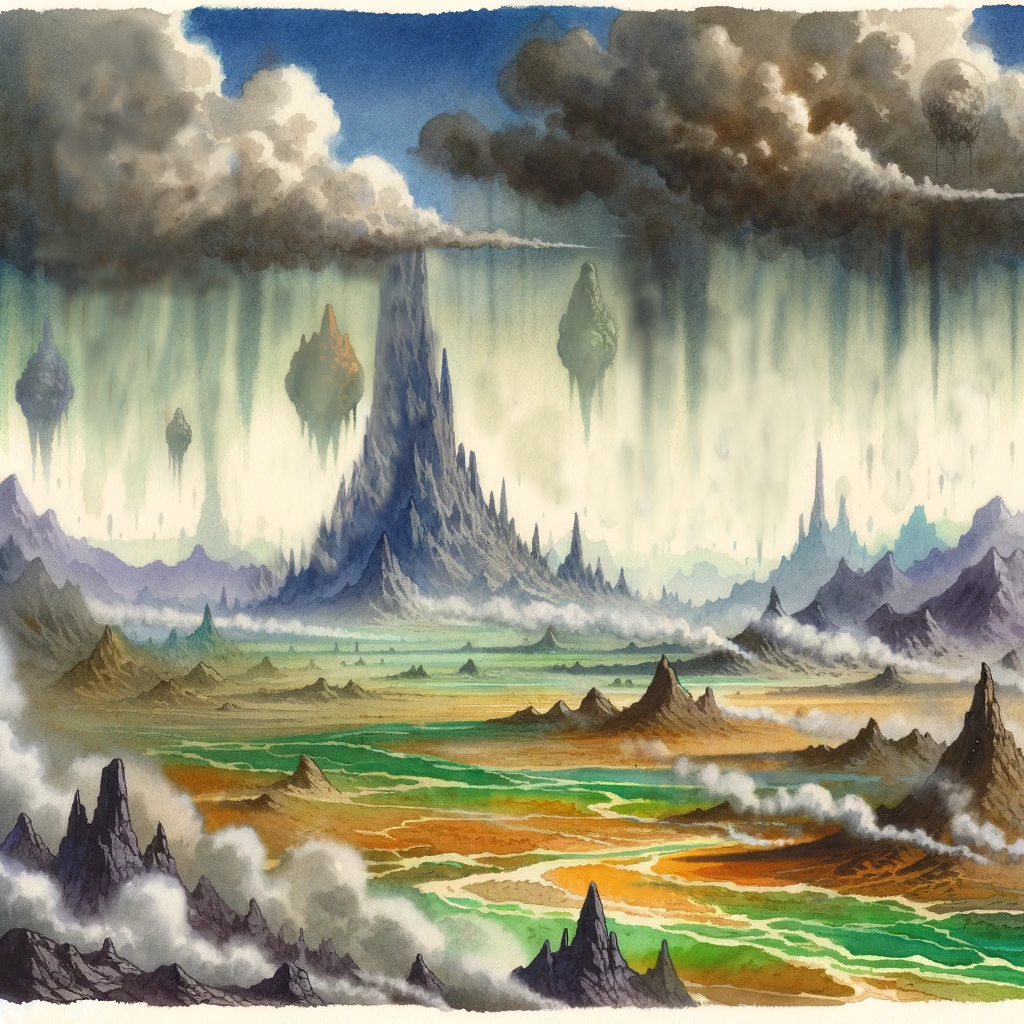
This month sees the last of the storms for a while, but brings new dangers. Toxic fumes and sulphurous gases billow across the land. They’re noticeable by their green or brown tinge, and sods in their path would do well to stay indoors for a few days and cover their windows. The rain’s got an acidic tang to it that blisters exposed skin and dissolves metal, so it’s best to avoid that too. Four diamond-shaped moons (the noxious mountains of Gehenna) linger above Torch the whole month, though their red light’s hard to see when the fog’s blowing in. There’s also an upsurge in volcanic activity during Infernus. It’s not the best loved of months, in all.
Hecatomb — Baator
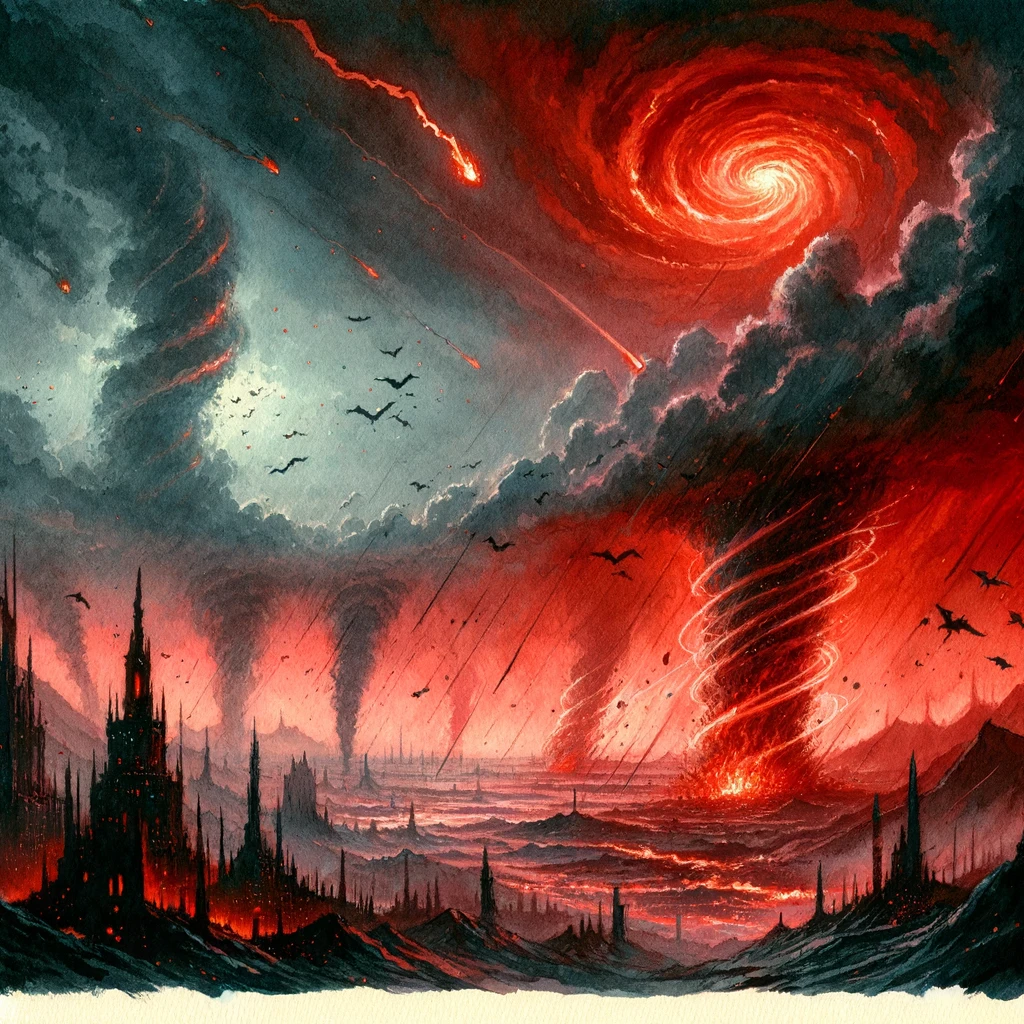
Hecatomb’s the last month of the Outland year, and it’s an arrogant one, for sure. It’s unique amongst the Outlands’ months, as it’s the local folk themselves who determine what terrors the weather holds. Offerings of slaughtered animals, jink and food to the powers of the skies bring a few days of peace. Burgs too poor (or too mean) to sacrifice valuables are struck down by storms, tornadoes and burning meteors! Those who garnish the weather powers well find they’re passed over, and the furies wreak revenge upon their less-generous neighbours instead. The ambient light of the Outlands’ skies adopts a hellish red hue for the whole month, and when the wind’s still, sharp-eared bloods fancy they can hear the distant screams of the tortured petitioners of Baator. It ain’t a pretty end to the year, but it’s a welcome one, for most.

Additional Days
Astral Days

Some planars forget this, but there’s more to the multiverse than just the Outer Planes. Most planewalkers’ve heard of the Psychic Winds of the Astral Plane, and sure enough, these are known on the Outlands. Every cycle there’s an extra week’s worth of individual days when these strange breezes bring their magic to the Land. On an Astral Day the sky’s a scary sight: Look up and it really does seem to go on forever. Moreover, high above the silver clouds you can see the thrashing, twining chords of the Astral, like a nest of infinitely long vipers in the sky. Guvners (who spend too much time reading books to look up at the sky) have noticed that Astral Days are often triggers for new portals to open up or old ones to shift or close down, though that ain’t a rule to rely on. Harder to grasp is the complex system they’ve calculated which predicts when the Astral Days fall; they space themselves out through the year in a complex pattern. You’d best ask a Guvner when the next one is: it’s too hard to work out for most bashers.
The Veiled — Outlands
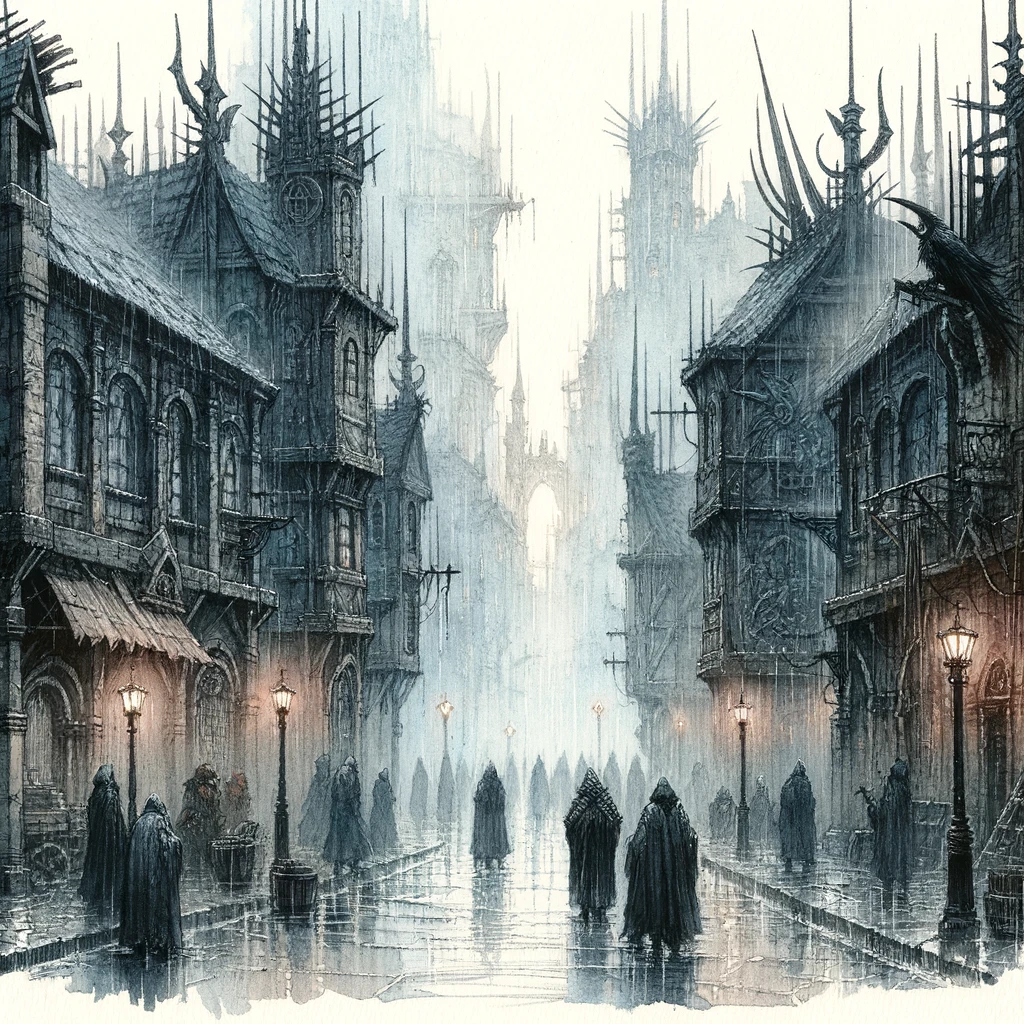
Did we say Hecatomb was the last month of the year? Well, it is, and it ain’t. See, the Veiled’s got its own strange story to tell. At least, that’s what the chant says; and the chant’s usually right when you pay enough for it.
Rilmani myths claim the Outlands used to have their own weather, like all the other planes. It wasn’t much to speak of: A kind of dreary, rainy, miserable sort of climate. This was many thousands of years ago, back in the times before Aoskar was banished from the City of Doors. The chant goes on to say that the Outland’s weather slowly disappeared, almost like it was being stolen, leaving the Plane-at-the-Centre with a weather-void. Now even a Clueless prime could have a stab at what happened to it…
It was about this time that the planar winds started to blow harder, bringing the weather of the other Outer planes with them. Dark whispers said that the Lady had trapped the Outlands weather in the Cage and the planes themselves were trying to fill the gap she’d left. Why? Who can say, cutter. To this day, though, the prevailing winds of the Outlands blow in from the rim towards the Spire, and presumably up it, too.
Well, it seems the Lady’s Cage is full of holes (but then rain never needed big holes to get through). Once per cycle Sigil’s miserable weather escapes and scurries across the Outlands like a mouse with a cat on its tail. During this time, the planar winds are repelled and whatever month is happening is sort of put on hold. Thing is, nobody can tell for sure when the Veiled Month (as it’s come to be known) will come; it seems to change year on year.
One thing’s for sure, though. Every few hundred years the Veiled Month happens bang in the middle of Revolvis, and that’s when the Modron March comes. Why? Who can say, cutter.
Source: Jon Winter-Holt, mimir.net; Outlands Calendar javascript by D’Arcey Carroll and Brian Mooney


